
He took a dolmus taxi to Bebek this time, making conversation with the other passengers so that he’d be remembered, a foreigner who spoke some Turkish. Anna had already been fed and changed for bed, a soft nightgown she seemed not to notice. “I’ll just sit with her until she falls asleep,” he told the nurse, holding up the magazine he’d brought to read. An open-ended visit, no need to check back. Fifteen minutes later he was through the garden entrance, on the road where Mihai was waiting.
Istanbul Passage by J.Kanon
Published by Simon & Schuster, 2013
I am following Leon Bauer, an American tobacco trader to Bebek, way off the beaten tourist path. Istanbul is a place to be if you are a spy as the WWII winds down to its victory lap. Turkey, a neutral country pressed between Allies and Axis for most of the war is a happening place.
Leon and his German Jewish wife Anna settled here when he pulled her out of Nazi Germany after atrocities of Kristal Nacht. Finally safe in Stamboul, she threw herself, and Leon marginally as well, into saving Romanian Jewish families by paying a ransom of $300 per head and then shipping them from Black Sea port of Constance (that we visited just three months ago!) through Istanbul to Palestine. During one of those heroic missions the hardly seaworthy ship full of Romanian children sinks while passing Dardanelles in the dark night. As Anna witnesses in horror the helpless Jewish children drowning in the waters of Marmara Sea she loses her mind and Leon has to place her into a mental sanatorium in Bebek, freeing him to do some spy and love work on the side. 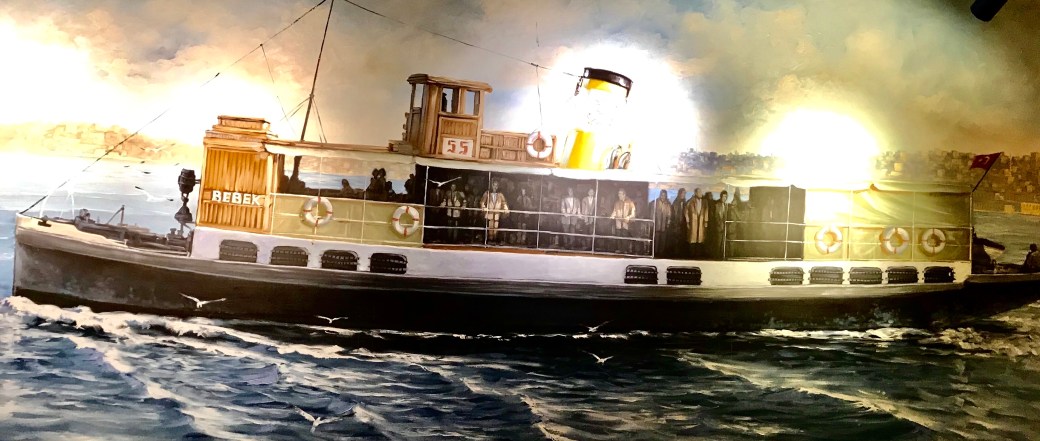 In 1945 Bebek was a small village on European side of Bosporus well outside the Stamboul city limits. Nowadays with Bebek becoming the playground of Istanbul rich, it is hard to imagine how this place looked then. As I read the book I envision a pier (iskelesi)
In 1945 Bebek was a small village on European side of Bosporus well outside the Stamboul city limits. Nowadays with Bebek becoming the playground of Istanbul rich, it is hard to imagine how this place looked then. As I read the book I envision a pier (iskelesi)
 and a simple café with a few shacks around it. Today there are numerous cafes and fancy restaurants including arguably the “Starbucks with the best view in the world”. On its walls you can admire lots of old references, including its location proudly shown on an old French Bosporus chart with Starbucks green logo slapped over it.
and a simple café with a few shacks around it. Today there are numerous cafes and fancy restaurants including arguably the “Starbucks with the best view in the world”. On its walls you can admire lots of old references, including its location proudly shown on an old French Bosporus chart with Starbucks green logo slapped over it. 
Since today’s ferries rarely stop at Bebek Iskelesi you can ride the ferry just to Arnavutköy enjoying the view of many yalis – spectacular  old palaces on the water, some converted into luxurious hotels.
old palaces on the water, some converted into luxurious hotels.
Modernity of steel, glass and concrete mingles with
 graceful marble mosques and old elite schools lining the shore of Bosporus. After you disembark at Arnavutköy (meaning Albanian Village in Turkish) Iskelesi, you can take a pleasant stroll to Bebek. But first you might want to stop for some good coffee and in pleasant weather you can continue enjoying your book in the sunny garden.
graceful marble mosques and old elite schools lining the shore of Bosporus. After you disembark at Arnavutköy (meaning Albanian Village in Turkish) Iskelesi, you can take a pleasant stroll to Bebek. But first you might want to stop for some good coffee and in pleasant weather you can continue enjoying your book in the sunny garden.
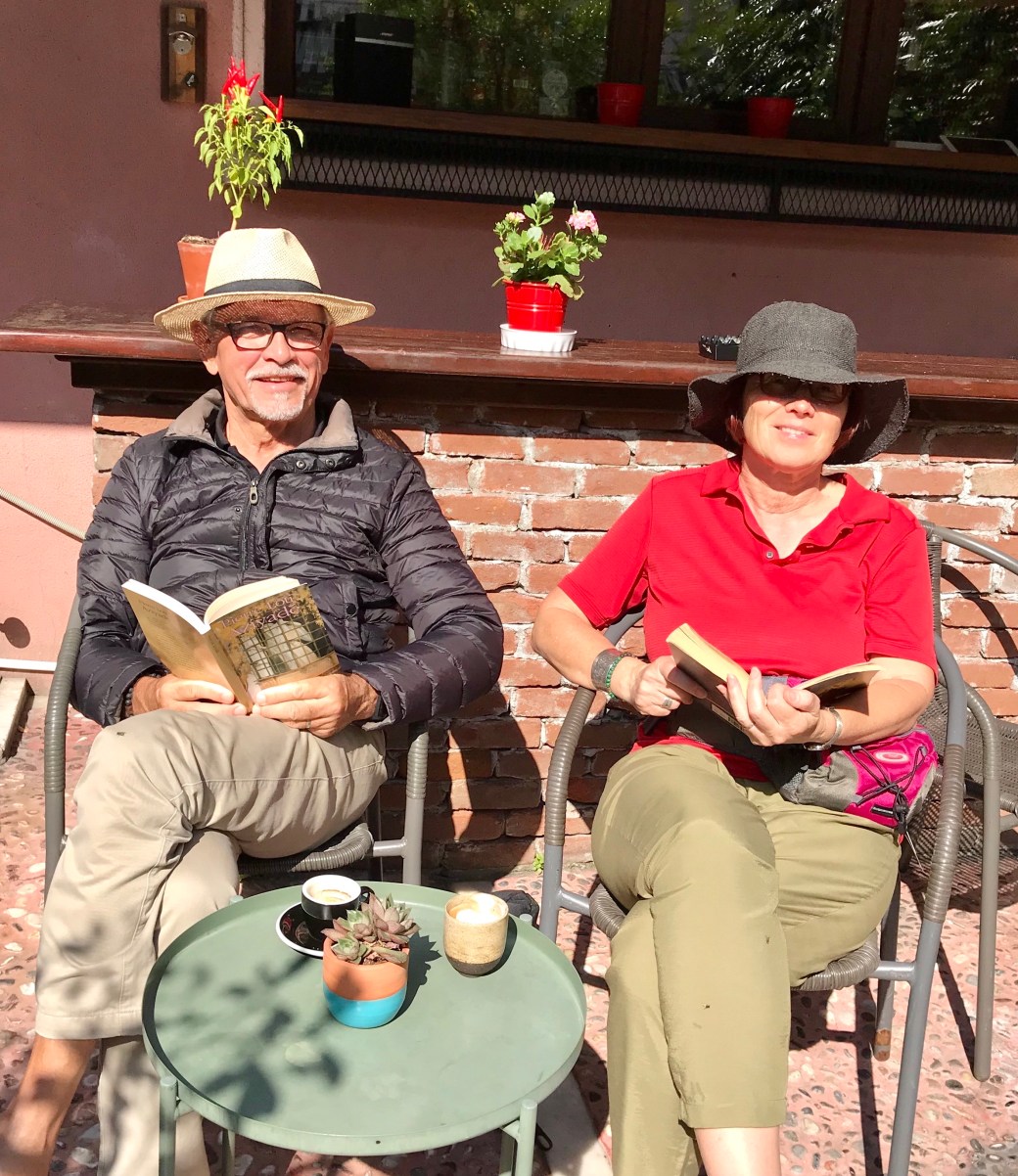 As you walk the bank you will notice you are between two gracious bridges spanning the Bosporus.
As you walk the bank you will notice you are between two gracious bridges spanning the Bosporus.  It took almost thirty years after the WWII ended before the first modern Europe to Asia Bridge was built, but by now there are two more completed and in service over this seaway, chock full of maritime traffic of all sorts.
It took almost thirty years after the WWII ended before the first modern Europe to Asia Bridge was built, but by now there are two more completed and in service over this seaway, chock full of maritime traffic of all sorts.
Here at the Bebek Pier the drama of Leon, Anna, and the other characters in this novel starts unwinding with many surprising turns and a lot of suspension. Before I reach the last page of the book I learn a lot about this town and the different districts of Beyoğlu, Pera, Karaköy, Tophane, Taxim, and Galata, where we are staying in the shadow of
 the old, round Galata Tower, looking across to the Old Town of Istanbul.
the old, round Galata Tower, looking across to the Old Town of Istanbul.
After this year’s intense travel I was very much relieved when we opted for our trip’s last installment to have a long stay in a place we both love very much. We have been coming here regularly since 1983 but so far we have not paid our dues and never stayed longer than a few days. But this time we completely reversed our modus operandi of one night stays and for a month played a role of an older settled down couple. Not well heeled, though, just look at our selfies… This decision has changed our travel style a lot. What a new experience waking up in the morning (is noon still considered a morning?) in our bright three window corner bedroom with a view, to make an important decision of our lives, eg. what to do with upcoming breakfast! At home? Or on our way somewhere?  Either way, while consulting our dear Istanbul DK Guide or blindly volleying different ideas to one another, we have to decide before our cleaning lady shows up at our door! When we finally kick ourselves out and walk towards our intended destination, then quite often, on the whim, we change our plans. Sometime intentionally as we are sidetracked by some interesting event unfolding in the streets, or unintentionally, after boarding the wrong ferry which unexpectedly takes us instead of to the distant terminal on the Golden Horn to an iskelesi somewhere on the Asian side of Bosporus!
Either way, while consulting our dear Istanbul DK Guide or blindly volleying different ideas to one another, we have to decide before our cleaning lady shows up at our door! When we finally kick ourselves out and walk towards our intended destination, then quite often, on the whim, we change our plans. Sometime intentionally as we are sidetracked by some interesting event unfolding in the streets, or unintentionally, after boarding the wrong ferry which unexpectedly takes us instead of to the distant terminal on the Golden Horn to an iskelesi somewhere on the Asian side of Bosporus!
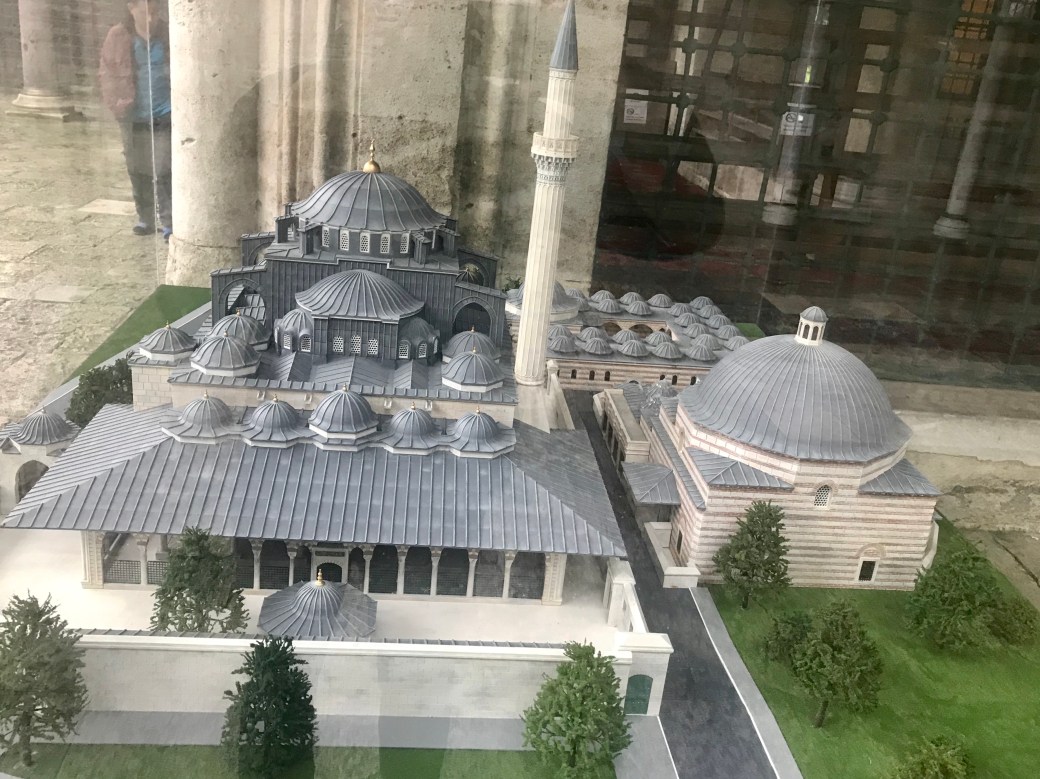 Number 15 was the second shop down from Hamami near the Kiliç Pasha Mosque in Tophane. The street was flat, behind the shipping terminals, and the shop was scarcely wide enough to fit a door and display window. The dusty framed photographs covered the usual ritual of family life: soldiers stiff in new uniforms, secular weddings, solemn young circumcision boys in round hats and white satin cloaks. In some of the older pictures the men still wore fezzes, steamed and pressed for the camera, already artifacts. According to a small sign, Enver Manyas offered a choice of backdrops-a garden pavilion, Seraglio Point, Bosporus views-but most of his customers seemed to have opted for less expensive plain canvas.
Number 15 was the second shop down from Hamami near the Kiliç Pasha Mosque in Tophane. The street was flat, behind the shipping terminals, and the shop was scarcely wide enough to fit a door and display window. The dusty framed photographs covered the usual ritual of family life: soldiers stiff in new uniforms, secular weddings, solemn young circumcision boys in round hats and white satin cloaks. In some of the older pictures the men still wore fezzes, steamed and pressed for the camera, already artifacts. According to a small sign, Enver Manyas offered a choice of backdrops-a garden pavilion, Seraglio Point, Bosporus views-but most of his customers seemed to have opted for less expensive plain canvas.
A bell tinkled when Leon opened the door, bringing out a short, round-shouldered man with wire-rimmed glasses. At first a look of surprise, then a guarded dip of his head .
“Efendi.” ”Merhaba. Manyas Bey?” The man nodded, still wary. “I have some work for you. From Mr. King,” Leon said in Turkish. Manyas stared at him, keeping his face composed, noncommittal. ”We are alone?” Leon said. Antoher nod, waiting. Leon reached into his pocket, pulling out Alexei’s passport. “Mr. King is dead,” Manyas said.
Istanbul Passage By Joseph Kanon Published by Simon & Schuster, 2013
Anyone who ever visited Istanbul knows the touristy areas of Sultan Ahmet (with Hagia Sophia and Blue Mosque) and Seraglio (with Topkapi Palace). But Tophane is not as well known and hence much less frequented, except for the ladies who come to the historical Ali Kiliç Pasha hamam 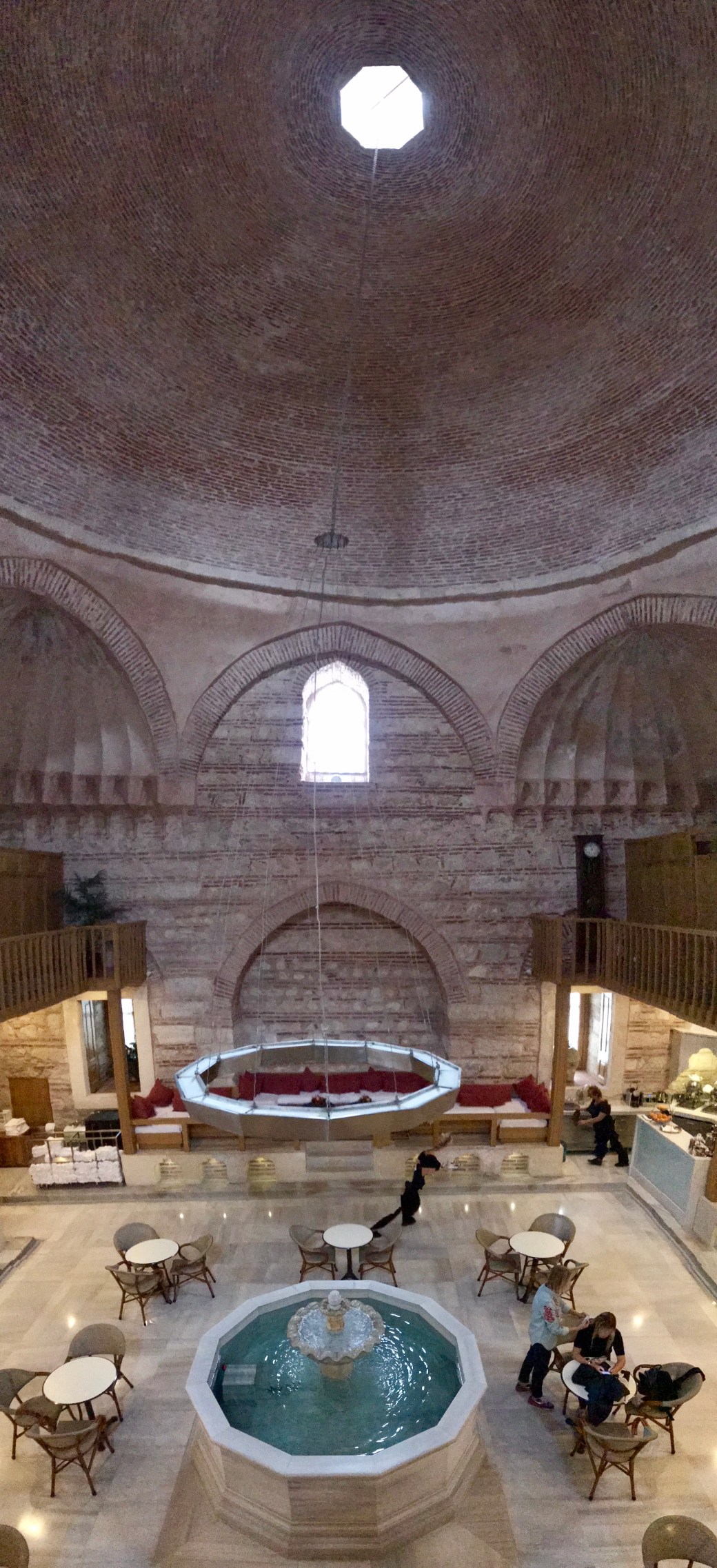 On a rare rainy day my wife decides to join them for a sweat, scrub and soap bubble massage, while I walk around, between the boutiques and arts cafes, hiding under an umbrella. Until my socks get sopping wet and I need to duck inside a pillow rich Han for a cup of hot tea and a few hours of quiet reading.
On a rare rainy day my wife decides to join them for a sweat, scrub and soap bubble massage, while I walk around, between the boutiques and arts cafes, hiding under an umbrella. Until my socks get sopping wet and I need to duck inside a pillow rich Han for a cup of hot tea and a few hours of quiet reading. 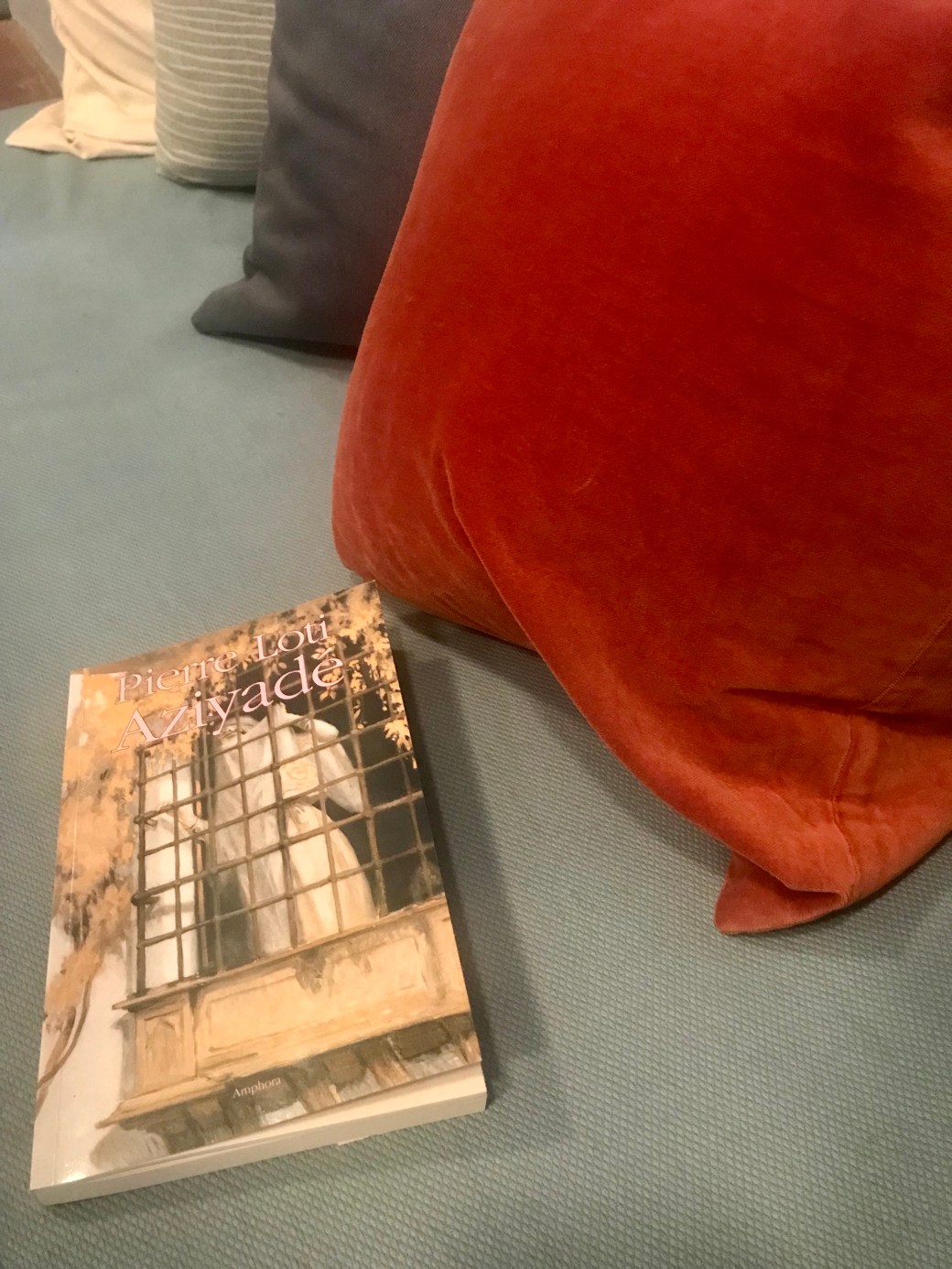 This marble clad, luxurious, and spotlessly clean hamami had been here in Tophane for more than three and half centuries waiting for Mr. Bauer to use it. Of course he did not have the time for it. From his conversation with Enver Manyas you noticed he was more interested in ordering a fake passport! But my wife sure enjoyed her time spent inside!
This marble clad, luxurious, and spotlessly clean hamami had been here in Tophane for more than three and half centuries waiting for Mr. Bauer to use it. Of course he did not have the time for it. From his conversation with Enver Manyas you noticed he was more interested in ordering a fake passport! But my wife sure enjoyed her time spent inside!
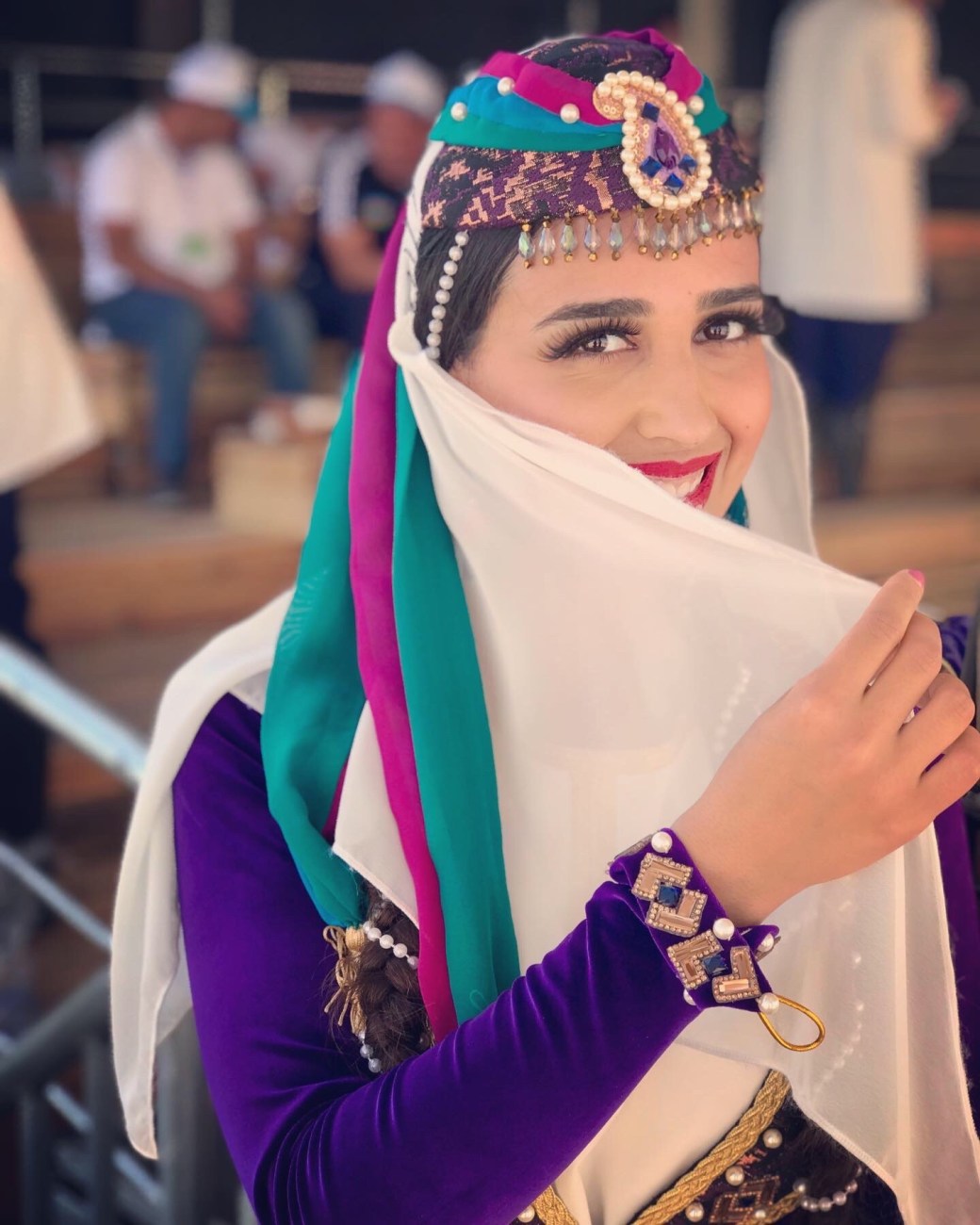 Eyoub, December 4th, 1876
Eyoub, December 4th, 1876
She is here! For the last two days I have been living in a fever of expectation. This very evening a caïque is to bring her to the landing-stage at Eyoub, opposite my house.
My informant is Kadija, the old negress who, those nights in the boat in Salonica, used to bear Aziyadé company and risk her life for her mistress.
From three o’clock onwards, I was waiting for her on the jetty. The day had been sunny and bright and there had been an unusual amount of traffic on the Golden Horn. Towards evening, thousands of caïques came alongside the Eyoub landing-stage, bringing Turks from their business in the crowded centers of Constantinople, Galata, and the Great Bazaar, back to their homes in the quiet suburb. I was beginning to be known at Eyoub and some of the men hailed me.
Aziyadé by Pierre Loti
Translated by Marjorie Laurie
Published by Amphora Egitim Yaynçilik,
First published 2006
Eyüp, as the district is known today, lies on the Golden Horn ‘s west end. On a sunny afternoon we easily reached the hill top with a funicular for a tulip glass of tea  and a magnificent view of the Golden Horn all the way towards the Bosporus seaway and the hills on its Asian side.
and a magnificent view of the Golden Horn all the way towards the Bosporus seaway and the hills on its Asian side.
 Sitting contentedly at Pierre Loti Café I started wondering who was the guy behind the name? Without a word my wife handed me a book.
Sitting contentedly at Pierre Loti Café I started wondering who was the guy behind the name? Without a word my wife handed me a book.
A book? Yes, a slim paperback titled Aziyadé. To start reading immediately, which I did!
This is what I really like when visiting a place. Read a book connected to the place. Submerge (look, stare and listen; my wife does the talking, people connection is so easy for her) into the local life, its pace and customs.
Well, the book is a historical novel depicting a love affair between a naval officer of certain Western Power named, you would not believe it, Pierre Loti, on assignment here in Istanbul, with a married Turkish woman named Aziyadé, one of four wives living in the harem of a local businessman.  As a pre-requisite for this story Aziyadé’s husband’s extensive business interests frequently take him on travels out of town, thus fatefully neglecting his four wives in general and Aziyadé in particular. Leaving the playground to his young and attractive competitor in white naval uniform with gold epaulets was not very smart. In fact it made it way to easy for Pierre to find himself in close, actually more than close, emotional relationship with the young beautiful wife as those two lovebirds took their chance. Before anybody could notice they started happily spending night after night in the house the mariner rented in Eyüp with the help of Azayidé’s servant Achmet and old Samuel from Balat, a Jewish village next to Eyüp.
As a pre-requisite for this story Aziyadé’s husband’s extensive business interests frequently take him on travels out of town, thus fatefully neglecting his four wives in general and Aziyadé in particular. Leaving the playground to his young and attractive competitor in white naval uniform with gold epaulets was not very smart. In fact it made it way to easy for Pierre to find himself in close, actually more than close, emotional relationship with the young beautiful wife as those two lovebirds took their chance. Before anybody could notice they started happily spending night after night in the house the mariner rented in Eyüp with the help of Azayidé’s servant Achmet and old Samuel from Balat, a Jewish village next to Eyüp.
Can you see the local connection now? Very, very interesting. As I read the book I have to make a few critical points. You have to excuse me, as I am not a writer and certainly not a literary critic, but I could not help noticing some disconcerting illogical elements in this literature of the Mexican telenovela quality, which were rather bothersome to my engineering mind, as the story played out in the milieu of Istanbul in 1876. For more romantic souls those issues may not be important as the steam of their love story easily envelops the mind of the excited reader. But for me it was not quite clear how the officer could handle the logistic of his affair; actually it was a mystery. Firstly, he had to fulfill the duty of the commanding officer on the frigate “Deerhound” during the day and secondly, by dark his call of duty continued in the couple’s Eyüp love nest. This intense activity performed nightly must have certainly been physically demanding and affecting his daytime service to his Country and the Queen. But then every evening to get from Bosporus to Eyüp (just look at the photo view from the Pierre Loti Café and see for yourself how distant the Bosporus is) while Aziyadé was already impatiently expecting him, was a major task (no underground metro or cars then) thus requiring a few nautical miles of rowing! Today, in our modern era, our government reps, diplomats and spies are moving effortlessly around in black Mercedes limousines or Masserattis. For them, it is a piece of cake. But our Loti must have been exhausted on arrival to Eyüp falling into the lap of his darling Aziyadé!
And then with the first signs of night dying he better be on his way rowing back to “Deerhound” to share his breakfast with his fellow officers. If he managed to board his ship on time at all! When did this poor chap sleep during that one year long affair? Understandably love is powerful and can clearly provide lovers with wings at the time of need. But still? This man was simply amazing and could have had served as a hero prototype to Ian Fleming when he created Agent 007!
Eyüp was the first Turkish district established after the conquest of Constantiopole in 1453 by Sultan Mehmed II. He built a mosque and turbeh (a mausoleum) to the Eyyub al Ensari, a standard bearer of prophet Mohammed, who is believed to have died here. Because many Ottoman wishes to be buried here close to the saint there are many many cemeteries stretching all the way up Pierre Loti Hill.
Remember old Samuel from the book? He hails from the next community over – Jewish Balat. This is where the Sephardic Jews settled after Catholic rulers of Spain Ferdinand and Isabella declared “Either you convert to Christianity or get out of here! And P.S. Even if you do, we won’t believe you and torture you in many gruesome ways.”
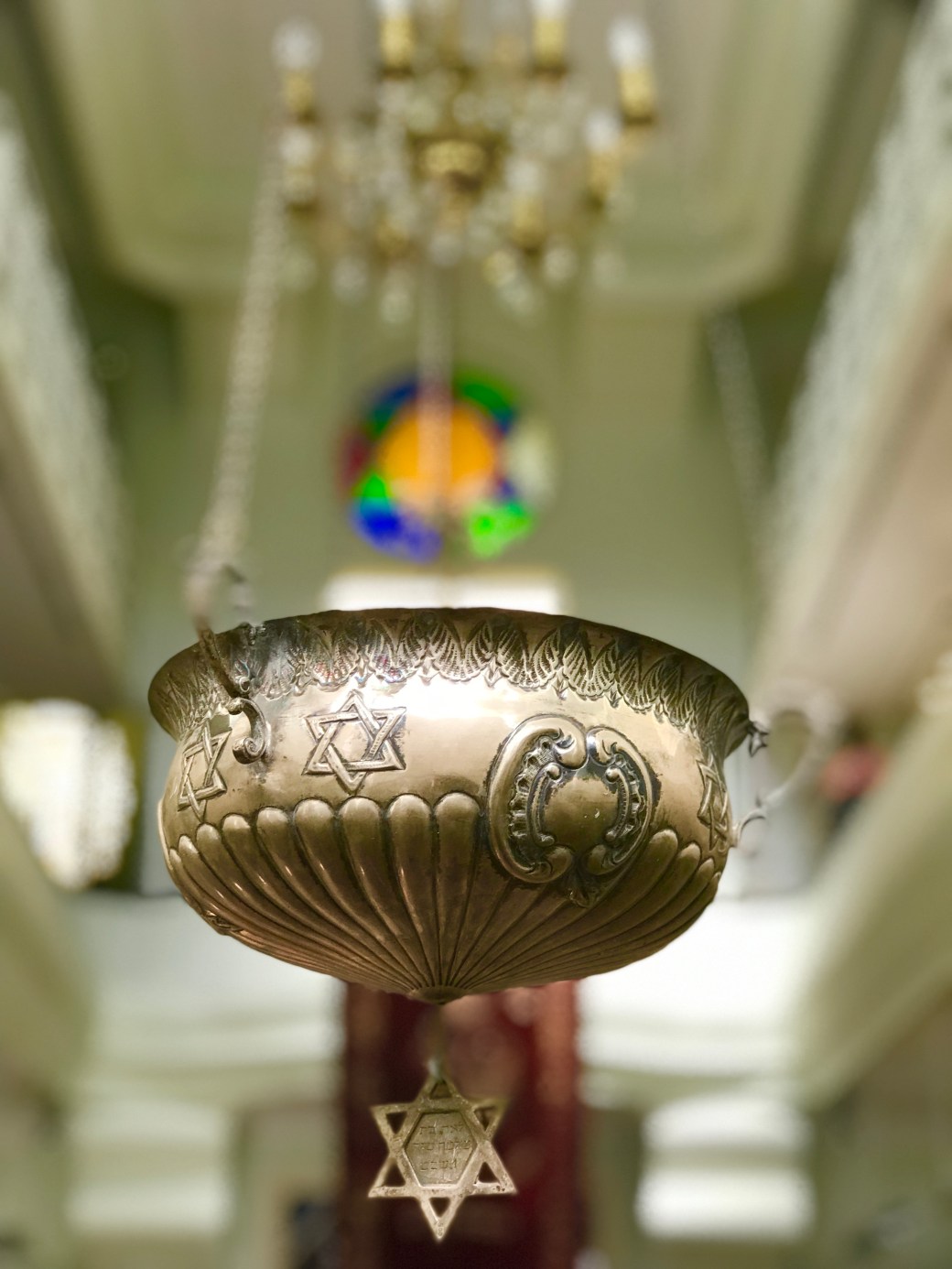 It was Ottoman sultan Beyazıt II who issued an open invite to the Jews and more than one hundred thousand of Sephardic and other Jews were welcomed to settle in Istanbul. Honestly, what an act of kindness from Muslim community!
It was Ottoman sultan Beyazıt II who issued an open invite to the Jews and more than one hundred thousand of Sephardic and other Jews were welcomed to settle in Istanbul. Honestly, what an act of kindness from Muslim community!
Balat today does not have many Jews left, and the big Archida synagogue is locked up and only accessible if you get a special permit from the high ups, we were told at the Jewish museum.  We didn’t try, instead we wandered around this up an coming colorful neighborhood where on the weekends young crowds come out for coffee, long drawn out Turkish breakfast and maybe a peek at the colorful Turkish wedding. We came across an unusual wedding celebration sight with two men dressed in long skirts, with bells on their fingers danced in the streets accompanied by a traditional band.
We didn’t try, instead we wandered around this up an coming colorful neighborhood where on the weekends young crowds come out for coffee, long drawn out Turkish breakfast and maybe a peek at the colorful Turkish wedding. We came across an unusual wedding celebration sight with two men dressed in long skirts, with bells on their fingers danced in the streets accompanied by a traditional band.  People were a bit embarrassed when we asked them about it; apparently this custom harkens back to the days of sultans when women dancers were only appropriate for the harems and non. Turkish beautiful young boys were trained to dance for the honorable guests. They also performed additional services after the dance, hence the embarrassment.
People were a bit embarrassed when we asked them about it; apparently this custom harkens back to the days of sultans when women dancers were only appropriate for the harems and non. Turkish beautiful young boys were trained to dance for the honorable guests. They also performed additional services after the dance, hence the embarrassment.
 The mosque of Sultan Mehmed-Fateh (Mehmed the Great) beheld Achmet and myself basking in the sun outside its great portico of greystone, – two of us lying there without a care in the world, lost in some vague dream not to be expressed in human speech. The square of Mehmed-Fateh, which lies high above old Stamboul, consists of wide open spaces, which are frequented by men in cashmere caftans and great white turbans. In the centre stands one of the largest and most deeply revered mosques in all Constantinople. The immense square is girt by mysterious walls, which are topped by a line of stone domes, like a row of beehives. These are softas’ dwellings, which no infidel may enter.
The mosque of Sultan Mehmed-Fateh (Mehmed the Great) beheld Achmet and myself basking in the sun outside its great portico of greystone, – two of us lying there without a care in the world, lost in some vague dream not to be expressed in human speech. The square of Mehmed-Fateh, which lies high above old Stamboul, consists of wide open spaces, which are frequented by men in cashmere caftans and great white turbans. In the centre stands one of the largest and most deeply revered mosques in all Constantinople. The immense square is girt by mysterious walls, which are topped by a line of stone domes, like a row of beehives. These are softas’ dwellings, which no infidel may enter.
This quarter is a center of purely Eastern activity. Camels traverse it with leisurely gait, their bell tinkling monotonously. Dervishes sit there, deep in pious meditation, and yes no tinge of Western Europe entered it.
Aziyadé by Pierre Loti
Translated by Marjorie Laurie
Published by Amphora Egitim Yaynçilik,
First published 2006
This Istanbul quarter and the mosque are named after the guy who conquered Constantinople for islam in the year 1453AD, effectively finishing the Byzantine Empire as we know it. To celebrate his accomplishment he decided to build a mosque in place of an old Byzantine church, then already in ruins. And because Mehmed II was the Conqueror of Constantinople, and in Arabic the conqueror is Fatih, he, his mosque and the part of town around it was named Fatih. When the 1766 earthquake struck Constantinople it leveled the poor mosque to the ground leaving only three parts of it standing. 
The ablutions fountain and three porticos – where Loti and Achmet spent their lazy sunny afternoons – of the courtyard plus the gate to the mosque Prayer Hall. Immediately after catastrophic earthquake Sultan Mustafa III called his Chief Imperial Architect and on the third attempt the Architect got it right. Light and spacious Prayer Hall is absolutely stunning! Unbearable lightness of engineering at its best.   And IT has already survived a quarter of millenia!!!
And IT has already survived a quarter of millenia!!!
When I said before: “Seeing one mosque/temple/pagoda/church is like seeing them ALL!” I did not mean one per day, but with thousands (3,113 to be exact) of mosques packed in the city of fifteen million, I am bound to see one mosque every day or at least every other day and to my big surprise I find them beautiful in infinite variations of the basic architectural principles.
Following Loti and his companion Achmet to the Fatih mosque I search not only for the place where they rested, but also the life they observed. While the tinkling of camel bells might be gone, the enormous market spilling over all the streets surrounding the mosque is the reflection of everyday life of Istanbul, probably not that different from the long days past. There are lovely rudy ripe tomatoes spilling over, 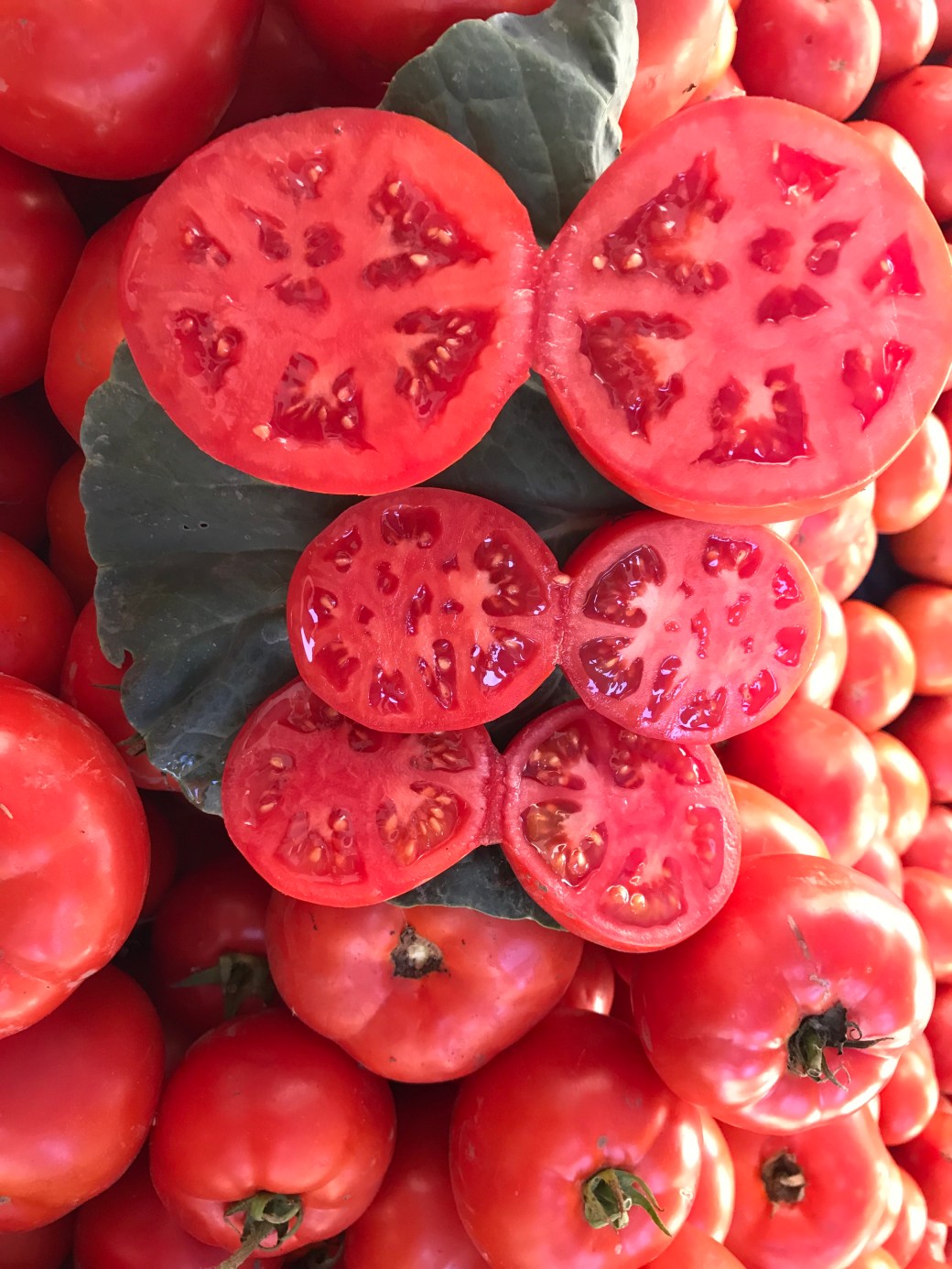 orange oranges, green (!) mandarins, glistening pomegranates,
orange oranges, green (!) mandarins, glistening pomegranates,  huge bunches of grapes, mountains of nuts
huge bunches of grapes, mountains of nuts  and sackfuls of chestnuts. Women bargain, children whine, men belt out prices. I would have welcomed an occasional snake charmer or a meditating dervish. Never mind, we find them at the Mevlevihanesi Muzesi (of the Sufi order of whirling dervishes), practically on our home’s doorstep.
and sackfuls of chestnuts. Women bargain, children whine, men belt out prices. I would have welcomed an occasional snake charmer or a meditating dervish. Never mind, we find them at the Mevlevihanesi Muzesi (of the Sufi order of whirling dervishes), practically on our home’s doorstep.
 Giving him self over to the hands of God, the first dervish started to whirl, the hems of his skirts gently swishing with a separate life of their own. We all joined in and whirled until there remained around us nothing but Oneness. Whatever we received from the skies, we passed on to the earth, from God to people. Each and every one of us became a link connecting the Lover to the Beloved. When the music ceased, we jointly bowed to the essential forces of the universe: fire, wind, earth, and water, and the fifth element, the void.
Giving him self over to the hands of God, the first dervish started to whirl, the hems of his skirts gently swishing with a separate life of their own. We all joined in and whirled until there remained around us nothing but Oneness. Whatever we received from the skies, we passed on to the earth, from God to people. Each and every one of us became a link connecting the Lover to the Beloved. When the music ceased, we jointly bowed to the essential forces of the universe: fire, wind, earth, and water, and the fifth element, the void.
The Forty Rules of Love
By Elif Shafak
Published by Penguin Books 2012
 On a Sunday afternoon in the dark museum hall we watch them whirl solemnly, somehow suspended between Heaven and Earth. There is only a few places in the world where one can witness this ancient ceremony and as much as I am uneasy that it is “performed” for the benefit of paying public, I do have to appreciate that it probably helps keep it alive and brings an introduction of a different, loving kind of Islam to a wide audience.
On a Sunday afternoon in the dark museum hall we watch them whirl solemnly, somehow suspended between Heaven and Earth. There is only a few places in the world where one can witness this ancient ceremony and as much as I am uneasy that it is “performed” for the benefit of paying public, I do have to appreciate that it probably helps keep it alive and brings an introduction of a different, loving kind of Islam to a wide audience.
Mevlana or Rumi, a 13th century poet is one of the most read poets in the world, but not everyone that admires his poetry is aware that his love poems were not penned for his wife, but his Sufi companion dervish Shams el Tabriz, upon his death. Shams’ powerful friendship influenced and transformed Rumi from an Islamic scholar and theologian to a Sufi mystic and poet. The novel by the most famous Turkish female author is an unusual double story of love: between Rumi and Shams and a Boston housewife Ella and Aziz, the author of a book about Rumi and Shams.
While not always available in bookstores (the conservative government has a bone to pick with her feminist views and her historical take on the killings of Armenians), she is obviously popular with the local readers. We even find Shafak’s books in coffee shops.
 Silence reigned until the Sultan spoke again. ‘Architect, you were ordered by my venerable father Sultan Selim to build a tomb for him. Weren’t you?’
Silence reigned until the Sultan spoke again. ‘Architect, you were ordered by my venerable father Sultan Selim to build a tomb for him. Weren’t you?’
´Indeed, your Highness. He wanted to be buried by the Hagia Sophia.’
´Build it, then. Start the work without delay. You have my permission to do what is necessary.’
‘Understood, my Lord.’
‘It is my wish to bury my brothers next to my father. Make the turbeh so grand that even the centuries on people can come and pray for their innocent souls.’
He paused and added in an afterthought,
‘But do not make it too spectacular. It should be just right size.’
And this is how, in the month of December, an early day in Ramadan, in the year 1574, Sinan in his capacity as Chief Royal Architect, and his apprentice Jahan, who had no place at this meeting and yet was present, were given the task of constructing inside the gardens of Hagia Sophia a monument that was large and impressive enough to befit five princes, the brothers of Sultan Murad, but neither so large nor so impressive as to remind anyone of how they have been strangled, on his orders, on the night he ascended to the throne.
The Architect’s Apprentice
By Elif Shafak
Published by Vikings 2014
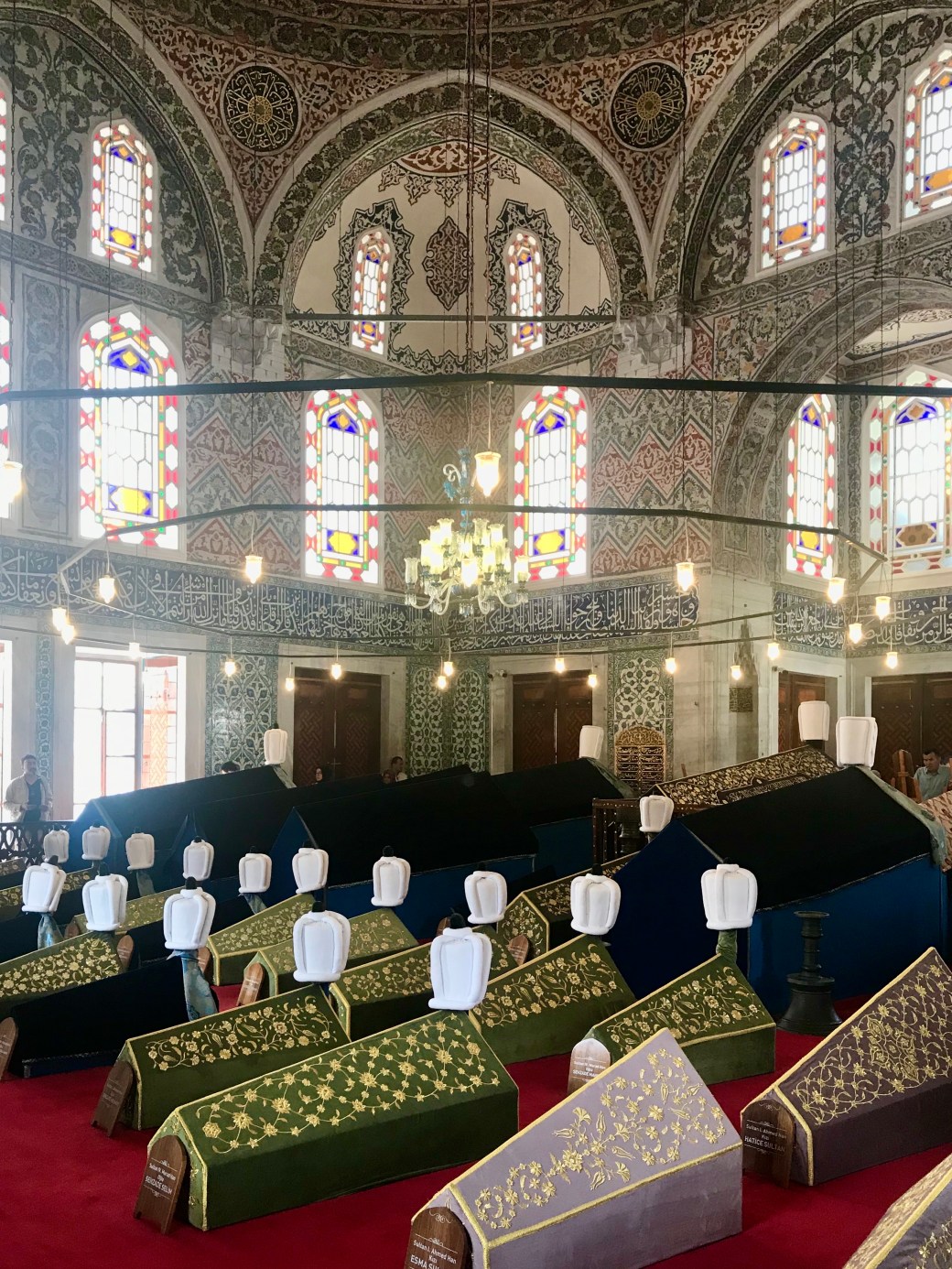 This was a moment typical for a newly installed Sultan. Ordering his deaf-mute servants to strangle his own brothers with a silk rope, so no royal blood is spilled and to avoid future fights among relatives for the Sultan throne. The record was 19 brothers and half brothers. Often it was the scheming mother of the new sultan who arranged it. It must have been a strange childhood, being a prince.
This was a moment typical for a newly installed Sultan. Ordering his deaf-mute servants to strangle his own brothers with a silk rope, so no royal blood is spilled and to avoid future fights among relatives for the Sultan throne. The record was 19 brothers and half brothers. Often it was the scheming mother of the new sultan who arranged it. It must have been a strange childhood, being a prince.
The most famous Ottoman architect of all, Koca Mimar Sinan Aga was Imperial Architect of a few Sultans in a row thanks to his long life, passing away at the age of 98.  Interestingly, he was born Armenian Christian, but was brought to Sultan’s Court by the Ottoman immigration program called Janissary recruitment, where young capable Christian boys were yearly taken from their villages to be converted to Islam and become part of elite Janissary troops. Apart from building 81 mosques Sinan left behind even more tombs, hamams and bridges, about 300 architectural monuments in all.
Interestingly, he was born Armenian Christian, but was brought to Sultan’s Court by the Ottoman immigration program called Janissary recruitment, where young capable Christian boys were yearly taken from their villages to be converted to Islam and become part of elite Janissary troops. Apart from building 81 mosques Sinan left behind even more tombs, hamams and bridges, about 300 architectural monuments in all.
It is hard to keep up with all his exceptional works as well as the succession of sultans he served,  so the novel about Sinan’s apprentice and elephant tamer Jahan, who comes from India to Istanbul as a boy, is a wonderful way to find our way through Turkish history and architecture. Sinan’s most famous work of art is Süleymaniye Mosque,
so the novel about Sinan’s apprentice and elephant tamer Jahan, who comes from India to Istanbul as a boy, is a wonderful way to find our way through Turkish history and architecture. Sinan’s most famous work of art is Süleymaniye Mosque, 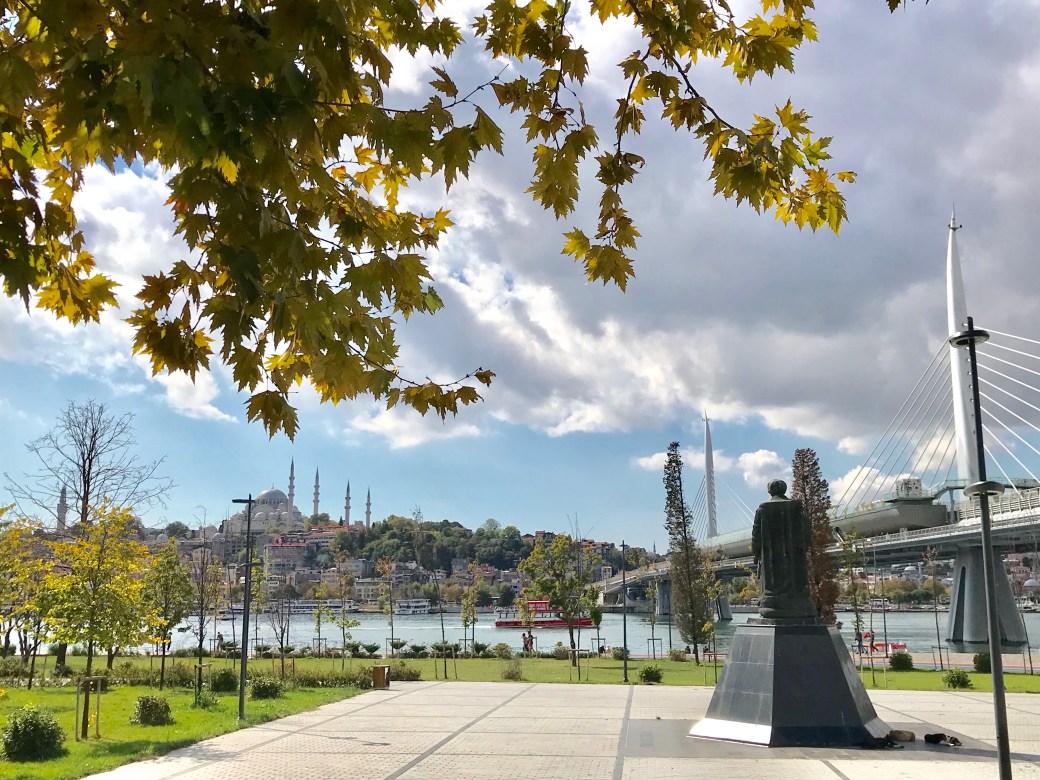 but it is the smaller works that delight as well. It is said that he was hopelessly in love with Suleyman’s daughter Mihrimah and built her two mosques on opposite ends of Istanbul where you could see the sun set and moon rise on the very day of her birthday.
but it is the smaller works that delight as well. It is said that he was hopelessly in love with Suleyman’s daughter Mihrimah and built her two mosques on opposite ends of Istanbul where you could see the sun set and moon rise on the very day of her birthday.
In Architect’s Apprentice the writer puts the apprentice in the role of unrequited lover, who in old age after many heartbreaks and loses finally leaves Istanbul to go back to India where he helps build the Taj Mahal.
On my night stand in our place under the Galata Tower three books are still waiting to be digested. Our one month Istanbul stay suddenly has only one week left.
As we leave our anniversary dinner one evening I ask my wife,
“Are you ready to go home?”
“Yes”, she replies.
“Really?” I am taken aback. “But where, do you mean California or Prague?”
“No, no, home to our place bellow the Galata Tower!”


What a Novel way to explore Istanbul. I thoroughly enjoyed the historical and romantic views.as well as the architectural lessons. I somehow think that California will be a little mundane after the past years of travel.
LikeLike
I am afraid you might be very right!
LikeLike
Such wonderful stories to go with your visit to Istanbul. Most intriguing photo of the many coffins of the sultan’s strangled brothers. Turkey is in the forefront of the news these days. One thing we have in common is earthquakes! Hope the rest of your travels continue to inspire.
LikeLike
Winding down on our year of travel. I am not quite ready to come home yet, though!
LikeLike
Hey there Mirek,What an erudite and thoroughly wonderful “post”. What a great idea to read books and then find all the paces in which it is set. Marvelous delicious history. Of course I know you know how lucky you two are to have each other as partners, especially for travel. I am properly envious, but so thankful that you share your adventures with us fans!!! Barbara (whom you met in Prague)
LikeLike
Dear Barbara, whom we met in Prague, and fondly remember, thank you for your kind words. It is indeed lucky to be able to share travels with a travel partner that has similar interests!
LikeLike
Barbara,
Thanks a lot for your kind words on our blog. We, both of us, put a lot of time and thinking into our blogs and while we mostly enjoy this process very much, it is also a process quite difficult and, I admit it, painful. As any creative cooperation could be. And I am not an easy guy to work with which my expedition leader knows very well when she goes through editing of my more than less politically incorrect writing or when we discuss different writing ideas. Or when we get exhausted fighting the WordPress software glitches and have to deal with our technical inability to handle them. We do believe that we write those posts first for ourselves. But when we decided to do the blog, the interaction with those who not only read our posts BUT who also put extra effort to share their feelings and give us the feedback is of utmost importance to us. Because when I feel like “This is it! I will never write another blog again!” then our readers comments start changing our mind and….may be I would try again. What the heck!
LikeLike
Of course we would feel bereft if you two stopped blogging and traveling. Sorry to hear about the pain..my illusion is nicked. Love you, Barbara
LikeLike
No worries. As long as we breath we will travel! 😉
LikeLike
Presumably that involves blogging in spite of the pain!!
LikeLike
Hm, luckily there is no pain. There must be a misunderstanding.
LikeLike
BRAVO👏 please don’t stop! U have created such a unique & fascinating picture of your life in Istanbul…midst the intrigues of history & literary explorations! And U do it with such aplomb! Having been there many years ago & having LOVED it during our own adventures, your fantastic fotoz bring back such fond memories…How we enjoyed out trips on the Bosporus…marveled @ the Blue Mosque, the Suleymania, and many others…U have basked in the history, culture, & daily life of this majestic city. Thanks so much for sharing it with us so eloquently, poetically & with such personal detail…I”m sitting on our deck with Kent & reading him your colorful passages…He can’t wait to explore it himself with Sereen…Your blogs & messages R inspiring him to follow in your imaginative & adventurous footsteps. What an amazing “Gift” U have created for yourselves as U explore the world. Can’t wait to here more of your stories & see your awesome fotos when U return.
😘🙏,
K.
LikeLike
I’m impressed with the amount of reading you got done in Istanbul!
I do very much enjoy historical fiction especially if I am traveling to the same location as the book.
Out of all the places you have been these last two years, Istanbul sounds the most exciting to me. It seems like such a vibrant city and I appreciate your relaxed travel style here. Crazy how much history is there too!
>
LikeLike
I love the historical context you wove through this post. The waterfront palace hotel looks amazing. I especially loved the colorful photo of the melons in the cart – something you would never see on the streets of San Francisco!
LikeLike
Look at you girls! Delighted to see your comments, otherwise I wouldn’t even know you read our blog. Yes, Istanbul is a very special place for both of us, and we just keep coming back there for last 35 years. Absolutely vibrant, incredible and colorful history, very pleasant residents of the city, and for me personally the bridges and efficient mass transit. Thanks for your comments, it was very sweet of you both!
LikeLike
I love your practice of reading books about the places you are, that really is an immersive experience
This is another great post about Istanbul which is keeping it very high on my “to do” list. Living “off the beaten track” and interacting so much with the locals is exactly my way of travelling which is probably why I am enjoying reading this so much.
LikeLike
Thanks Fergy, I hope you feel better and ready to make some travel plans!
LikeLike
Moc hezké čtení o čtení, Mirku. Putovat a poznávat kraje s knihou v ruce – co může být hezčího? Přeju krásný zbytek cesty a těším se na shledanou.
Hana
LikeLike
When I finally came to the end of this post, I released a long sigh. Similar to what I do when I get to the end of a book I know I will miss. You two are astounding. I was transported from where I sit in modern day California to Istanbul through the ages. Only once did I leave the readers dreamscape to see how much I had left to read… worried it would suddenly end. Mmmmm. Mmmmmm. Delicious it was! I could feel, hear, taste, smell and be where you took me. So well done. Thank you for enduring the pain that creative birthing can be. Winston Churchill said to be successful in life, you just need to make one person breath easier. I know there’s lots more to recipe, but my, did I breath easier, away from my world, immersed in the worlds you shared. Bravo, and thank you!
LikeLike
Wow, thanks for this essay on the joys of reading and being transported to another world. I do hope you get to experience it very soon.
LikeLike